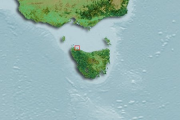Sediment particle size
Type of resources
Topics
Keywords
Contact for the resource
Provided by
Years
-
A total of 111 estuaries of moderate or large size were recognised around Tasmania and associated Bass Strait islands. The catchments of these estuaries were mapped using GIS, and available data on geomorphology, geology, hydrology and rainfall collated for each estuary and catchment area. Tasmanian estuaries were classified into nine groups on the basis of physical attributes that included salinity and tidal data collected during a field sampling program. Baseline information on the abundance, biomass and estimated production of macrobenthic invertebrate species was collected during a quantitative sampling program at 55 sites in 48 Tasmanian estuaries. These data were generally obtained at three different intertidal levels and two shallow subtidal depths at each site, and included information on a total of 390 taxa and over 100,000 individuals. Data on the distribution of 101 fish species, as obtained during surveys of 75 Tasmanian estuaries using seine nets by Last (1983) with some supplementary sampling, were also incorporated into the study.
-
Water quality and biological data was collected from four tide-dominated river estuaries indicative of catchments with varying levels of human impacts to: 1) assess draft indicator levels for water quality, and 2) investigate biological indicators of estuarine health in NW Tasmania. The data represented by this record was collected in the Duck Bay.
-

Water quality and biological data was collected from four tide-dominated river estuaries indicative of catchments with varying levels of human impacts to: 1) assess draft indicator levels for water quality, and 2) investigate biological indicators of estuarine health in NW Tasmania. The data represented by this record was collected in the Detention River.
-
Water quality and biological data was collected from four tide-dominated river estuaries indicative of catchments with varying levels of human impacts to: 1) assess draft indicator levels for water quality, and 2) investigate biological indicators of estuarine health in NW Tasmania. The data represented by this record was collected in the Black River.
-
Water quality and biological data was collected from four tide-dominated river estuaries indicative of catchments with varying levels of human impacts to: 1) assess draft indicator levels for water quality, and 2) investigate biological indicators of estuarine health in NW Tasmania. The data represented by this record was collected in the Montagu River.
 IMAS Metadata Catalogue
IMAS Metadata Catalogue